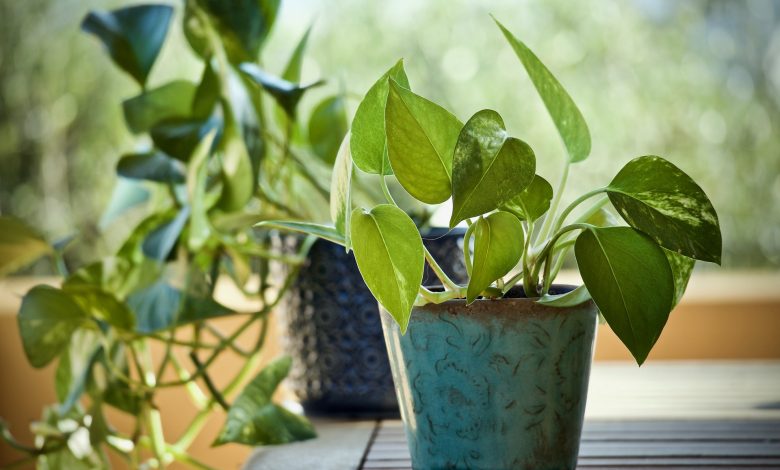How to Care for Pearls and Jade Pothos

Pothos plants are among the most popular houseplants due to their hardy green leaves and ease of care. Pothos are not ordinary houseplants, either. They are a type of vine that can curl and crawl its way around whatever your imagination has in store. Some popular placements include hanging baskets, trellises, windows, mantles, and mirrors. The pearls and jade pothos is a more colorful variety, and its size is on the slightly smaller end of the spectrum. Below you will learn all about pothos, specifically how to care for pearls and jade pothos plants.
The pearls and jade pothos is also referred to as devil’s ivy. Pearls and jade pothos have smaller leaves than traditional pothos plants and feature white or yellow mottling and marbling throughout the leaves. The parent plant of the pearls and jade is known as the marble queen, which has broader leaves up to three inches long. Although the pearls and jade pothos is slightly smaller and grows at a less rapid pace than traditional pothos plants, it will still require a large container or a terrarium if grown indoors.
If grown outdoors, the pearls and jade will quickly cover the ground, but it will not start climbing up structures without your help.

Botanical Information
The pearls and jade pothos is a member of the Araceae family. The botanical name for the pearls and jade pothos is the Scindapsus aureus.
Native Habitat
The pearls and jade pothos is native to the dry regions of South America and Mexico.
Flower
Flowers are not a common sight on pothos plants and will typically never be seen indoors. In order for the plant to flower, it must reach close to 40 feet in length, which is much easier to cultivate outdoors. Pothos flowers are not the main attraction or even a sideshow for most growers.
Appearance
As a trailing vine, the pearls and jade pothos will not climb along supports on its own. To grow the plant up a trellis, for example, you must tie the vine every few inches to keep it growing in the right direction. The trailing effect is perfect outdoors for an area where you are looking for ground cover. The trailing effect means that the stem will trail behind new growth.
The benefit of a trailing vine is that you can coax it to grow wherever you would like. You do not have to worry about the plant growing with a mind of its own and tightly wrapping or suctioning itself to unintended structures or places. Trailing vines grow without a care in the world and are easily placed wherever you desire.
If grown indoors, the pearls and jade will grow to about eight inches tall and 1.5 feet wide. Outdoors, the plant could eventually reach up to 40 feet in length in the right circumstances.
Leaves
The leaves of the pearls and jade pothos are the headlining act. Traditional pothos leaves are mostly green, but the pearls and jade variety provides a new unique look on each individual leaf with splashes of white or yellow marbling the deep green background. Leaves are heart-shaped and come to a point at the end.
Hardiness Zone
Luckily, the pearls of jade makes for an excellent houseplant because there are not many areas in the United States where you can grow them outdoors year-round. Pothos plants are hardy only in zones 10-11, which limits them mainly to south Florida and southern California.

How to Care for Pearls and Jade Pothos
When caring for pearls and jade pothos, the main activity you will be doing is pruning the plant and steering it to grow in the right direction. It does not require much attention in the way of water or fertilizer and is also not picky about sunlight. The biggest concern when growing a pothos plant is its rapid expansion out of its current container. Rarely, the plant will overwhelm a pot to the point of breaking it as it expands outward.
Sunlight
If grown outdoors, you should make sure that the pearls and jade does not receive too much sunlight. Partial shade is ideal. With too much sunlight, the leaves will burn and will begin to lose their distinctive marbled look. When grown indoors, direct sunlight will achieve faster growth.
Water
Less is better when it comes to watering the pearls and jade. This plant can withstand a large amount of abuse when it comes to forgetting to water it. And conversely, overwatering the plant can cause the roots to rot. Only water the plant when you can see and feel that the top layer of soil is beginning to dry out. In the fall and winter, allow the top layer of soil to dry out completely before watering again.
When it comes to humidity, the natural humidity of your house will keep the plant happy in the warmer months. If your house becomes particularly dry in the winter, though, you should give the plant a quick misting every other day.
Soil
Due to their lack of water requirements, pothos plants prefer well-draining soil. A potted cactus mix will work wonders for your pearls and jade plant. To help further with drainage, add a layer of pebbles to the bottom of the pot. If you want to get technical with your soil, pothos plants prefer a slightly acidic mixture between 6.1 and 6.7 pH.
Fertilizer
You should not need fertilizer if the plant is in quality soil. In potting soil, though, you should add a balanced fertilizer once a month. If you notice the plant is not growing as expected or looks unhappy, try adding a balanced fertilizer every other week until you notice improvement.
Temperature
The pearls and jade variety of pothos prefer temperatures between 60 and 85 degrees Fahrenheit (15 to 29 degrees Celsius). If grown outdoors, it can withstand a quick cold period down to 50 degrees Fahrenheit (10 degrees Celsius), but if the temperatures drop any lower, the plant will die.
Toxicity
Pothos plants are toxic to humans, cats, and dogs. The toxicity of the plant comes from calcium oxalate crystals. If ingested, these toxins can cause irritation on the tongue, lips, and mouth.
If you have a pet that takes an interest in your houseplants, the pothos is not for you. And even if your pet has not tried to eat the leaf of a houseplant yet, it’s better to be safe than sorry. If you have cats or dogs, you can still enjoy a pothos plant, but be sure to plant it on a high shelf or hanging basket that is completely out of reach.
Pests
Pothos are generally pest-free plants, but mealybugs may find their way in and feed off the sap of the stem. Mealybugs are extremely small but are still visible, looking like small swabs of cotton hiding in the joints of the stem. To proactively prevent them, you can wipe down the stem with rubbing alcohol. An alcohol-soaked cotton swab will also be the easiest way to remove them from the plant.
Propagation
As a fast-growing plant with many different offshoots, propagating pothos plants is simple and painless. Cut off a few different sections to start a new plant. The sections should be at least a foot long because half of that is going to eventually be placed in the soil. Next, remove two leaves near the cut end. New roots will be growing out of the stem where you cut off these leaves.
Now, soak your cuttings in water for two weeks. Old salad dressing containers can work well for this initial storage. But any tall jar with a narrow opening will suffice. Once you see roots form, transfer the new plant to a container.
One pothos plant can quickly become two or three using this method. And it can be a lot of fun to find new places to grow your plants.
Medicinal Uses
While there are not any specific medicinal uses for pothos plants, they are one of the best air-purifying houseplants that you can grow. Pothos has been shown to remove pollutants in the air, such as carbon monoxide, benzene, formaldehyde, xylene, and toluene.

Other Types of Pothos Plants
Here are four additional popular varieties of pothos plants:
Marble Queen Pothos
Mother to the pearls and jade, the marble queen is grander in scale than its offspring. The main difference between the two plants is that the queen has a truly marbled look, while the pearls and jade have larger patches of both green and white.
Silver Satin Pothos
The silver satin is a better-dressed version of the pearls and jade. If you prefer silver streaks rather than white marbling, look for a silver satin pothos.
Golden Pothos
The golden pothos resembles the pearls of jade, only with a golden yellow color in place of white.
Neon Pothos
For a change-up from the mottled look of most pothos plants, the neon provides a bright uniform shade of light green. The neon variety will grow to the same size as most other pothos plants.



